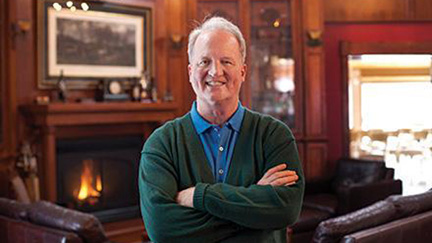18 Must Read Golf Books
By Tom Abts
We’re probably a few weeks away from the golf season. What’s better than to sit by the fire and read a good book – especially a golf book. Here are 18 must read golf books:
The Front Nine:
THE GREATEST GAME EVER PLAYED by Mark Frost
SIR WALTER by Tom Clavin
THE STORY OF AUGUSTA NATIONAL by Clifford Roberts
THE SPIRIT OF ST. ANDREWS by Alister MacKenzie
THE LITTLE RED BOOK by Harvey Pennick
IT’S ONLY A GAME by Jackie Burke
PURE GOLF by Johnny Miller
A GOOD WALK SPOILED by John Feinstein
THE MATCH by Mark Frost
The Back Nine:
DOWN THE FAIRWAY by Bobby Jones
DOCTOR GOLF by William Price Fox
GOLF IN THE KINGDOM by Michael Murphy
HOW TO PLAY YOUR BEST GOLF ALL OF THE TIME by Tommy Armour
ON LEARNING GOLF by Percy Boomer
POWER GOLF by Ben Hogan
SWING THE CLUBHEAD by Ernest Jones
THE DOGGED VICTIMS OF INEXORABLE FATE by Dan Jenkins
THE HISTORY OF AMERICAN GOLF by Herbert Warren Wind
We have to start with “The Greatest Game Ever Played” by Mark Frost. Frost has two books in this list – and they’re both must read. But this book is the story of young Francis Ouimet, a 20 year old caddie from the wrong side of the tracks in Boston, who beats superstar golf professional Harry Vardon to win the U.S. Open. It’s a real life “Rocky” story and it changed golf in America. The movie is good but the book is better.
As much as Francis Ouimet did for American golf, Walter Hagen did even more. “Sir Walter” by Tom Clavin captures the personality that changed the image of the American Golf Professional. Hagen should be the Patron Saint of the PGA – club pros and TOUR pros. A little known fun fact: Hagen almost won the Open that Ouimet did… and his victory would been have almost as shocking.
Sir Walter played exhibitions against Bobby Jones – as was romantically portrayed in the movie “Bagger Vance.” They were two different cats, but both very good players and very good for golf. Their match in Florida in 1926 was the equivalent of a heavy weight boxing championship. Jones retired from golf after winning the Grand Slam in 1930, and devoted his life to the Augusta National Golf Club. But, the man who really ran Augusta National was Clifford Roberts. Roberts tells all about it in “The Story of the Augusta National Golf Club.” From the first Masters in 1934 until today – the Masters is why Augusta National exists. The story behind the club and the Masters is necessary for an understanding of the American golf scene.
The golf course architect of Augusta National was Alister MacKenzie. MacKenzie is the author of “The Spirit of St. Andrews.” MacKenzie was a medical doctor who believed that he could do more good for people designing golf courses than in his medical practice. This book is really a treat for those who love history and the root of things. MacKenzie has chapters on The Evolution of Golf, and Ideal Holes and Golf Courses. His final chapter – Some Thoughts on Golf – is gold to those of us who share his worldview. Here are some of his thoughts, “The only reason for the existence of golf and other games is that they promote the health, pleasure and even the prosperity of the community.” “Health and happiness are everything in this world. Money grubbing, so-called business, except insofar as it helps to attain this, is of minor importance.”
An American who shared much of the same attitudes as the Scotsman MacKenzie, was Harvey Penick. His book “The Little Red Book” is the best selling golf instruction book of all time. It features a blend of simple wisdom, sound golf instruction, and good common sense. A must read.
Another Texas golf legend – Jackie Burke, Jr. – wrote “It’s Only a Game.” The title is misleading – golf has been Burke’s life. At 92, he’s still at Champions Golf Club in Houston almost every day – the club that he and Jimmy Demaret founded in 1954. Burke was a great player – a Master’s champion – and a great teacher. In fact, he reiterates Harvey Penick’s famous line of “Take dead aim” when about to hit a golf shot.
Another all-around golf legend is Johnny Miller. Miller has been the best television golf commentator for the past few decades. Many people don’t know that Miller was a fantastic player – his final round 63 to win the US Open at Oakmont might be the best round ever played. He also has unbelievable knowledge and insight into the golf swing. His book “Pure Golf” is straightforward and genius. I can’t believe how it flies under the radar.
The PGA TOUR basically started with Walter Hagen, then grew with Hogan and Snead and Nelson, but really took off with Arnold Palmer and television. John Feinstein spent more than a year on the PGA TOUR and helps you understand the complex mix of psychology, group dynamics, and political pressures that make athletes tick. He’s a great storyteller that gets you into the heads and hearts of the champions and strugglers. Though Mark Twain’s famous assessment of golf rings true “A Good Walk Spoiled” is a book that even Twain would enjoy.
I started this review with a book by Mark Frost and am ending the “Front Nine” with a book by Mark Frost – “The Match.” The match the book refers to is between professional golfers Ben Hogan and Byron Nelson vs amateur golfers Ken Venturi and Harvey Ward. Unlike the Hagen – Jones matches, this match was held under the radar. But the significance was almost as important as Hagen vs. Jones.
All of these books deal with the magic of golf – amateur or professional, teacher or historian, club manager or tournament chairman. They all capture the unique charm and magic that is golf.
The “Back Nine” continues with books that are a combination of history, humor, instruction, and biography. Why so many instructional books on the list? Because the golf swing is probably golf’s greatest mystery. The instructional books here are not new, but all of modern golf instruction comes from these four books.
Who is the greatest player of all time? We could never settle that argument. But the greatest writer of golf who was also a golf champion is Bobby Jones, so let’s start with his book DOWN THE FAIRWAY.
Jones wrote DOWN THE FAIRWAY when he was only 25. He had just finished winning the U.S. Open and the British Open in the same year and wanted to write while he thought he was at the pinnacle of his career. It’s shocking to read how insightful and humble he was at such a young age. Jones makes it clear that he wasn’t always on his A game, and that some days the game felt impossible – even to him. Jones had a nervous temperament and tournament golf was very hard on him. He gives the reader an inside look at the mind and emotions of one of golf’s all time greats.
Though Bobby Jones was from money and was an old school golfer, he was not a snob. That can not be said about Dr. Golf. William Price Fox makes fun of the blue-blooded types that epitomized golf about 100 years ago in his book DOCTOR GOLF. Is it funny? Yes, if you enjoy absurd humor. This doctor is the owner of the fictional golf sanctuary Eagle Ho, and answers golf questions in the form of “Dear Abby.” The game of golf has had to wrestle with being perceived as as hotbed of exclusion and snobbery since it came to America. Doctor Golf does everything he can to portray that attitude. One frustrated writer says it best, “Is there always this almost unbearable attitude of superiority in your messages?”
On a totally different wave-length is the mystical, magical GOLF IN THE KINGDOM by Michael Murphy. Murphy’s semi-autobiographical account of a young American philosophy student on his way to India via a stopover in Scotland where he meets Shivas Irons. Shivas loves the heart and soul of golf in a way that Dr. Golf pretends to. Shivas opens our traveler’s mind to the idea that golf is a vehicle to enlightenment – the type of enlightenment that he is seeking in India.
Though Shivas Irons was supposed to be a golf star, he never explains how to swing the golf club. Tommy Armour was a golf star and explains how to swing the golf club in HOW TO PLAY YOUR BEST GOLF ALL OF THE TIME. This is my all time favorite golf instructional book. I love the tone and especially love the common sense attitude towards playing golf.
A very different attitude, but a very valid and fascinating look at the golf swing comes from Percy Boomer in his book ON LEARNING GOLF. Boomer is the guy who came up with the visual of “turning your hips in a barrel.” Boomer’s a very intelligent fellow and his ideas of the golf swing are very sophisticated. He livens it up with his interludes where he discusses the golf swing with such people as a world famous mathematician and a world-class dancer.
Boomer’s theories are evident in Ben Hogan’s POWER GOLF. Hogan is credited with the start of the modern swing that relied more on the big muscles and less on the hands. I believe that Percy Boomer’s book actually lead the charge, but Hogan’s book was the big breakthrough – especially in America.
The anti-modern swing bible is Ernest Jones’ SWING THE CLUBHEAD. Jones lost a leg in WWI but continued to be a champion golfer because he could “swing the clubhead.” You need to hear his mantra and see the pictures of a little girl making a perfect swing.
But golf isn’t only about the golf swing. Dan Jenkins wrote about golf for many years in Sports Illustrated and Golf Digest. Some of his best essays are in his book THE DOGGED VICTIMS OF INEXORABLE FATE. The title came from Bobby Jones description of tournament golfers. Jenkins captures the many sides of golf, and very often in humorous fashion.
But the king of golf writers is the late Herbert Warren Wind. Though his name can seem pretentious and he wrote for the New Yorker magazine, Wind is down-to-earth and captures the charm and history of our game in THE HISTORY OF AMERICAN GOLF.
































